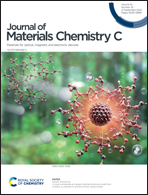Bulk heterojunction organic photovoltaic cells based on D–A type BODIPY small molecules as non-fullerene acceptors†
Abstract
Two non-fullerene small molecule acceptors based on CF3-4,4-difluoro-4-bora-3a,4a-diaza-s-indacene (BODIPY) as the central acceptor core and different donor terminal triphenylamine and carbazole units denoted as CF3-BDP-TPA and CF3-BDP-Cz, respectively, were designed and synthesized, and their optical and electrochemical properties were investigated. Both CF3-BDP-TPA and CF3-BDP-Cz showed a narrow bandgap, similar to the well-known Y6 acceptor. The molecular dipole moment of CF3-BDP-Cz is 5.53 D, which is significantly larger than that of CF3-BDP-TPA (3.347 D) and leads to strengthening the intramolecular (C–H⋯π) interaction, thereby enhancing molecular packing. We have used conjugated polymer PBDB-T as the donor (HOMO = −5.22 eV and LUMO = −3.45 eV), having complementary absorption spectra to both CF3-BDP-TPA and CF3-BDP-Cz. The optimized polymer solar cells based on CF3-BDP-TPA and CF3-BDP-Cz attained power conversion efficiencies of 9.89% and 13.07%, respectively. The higher PCE for the CF3-BDP-Cz-based device is linked with the larger dipole moment of CF3-BDP-Cz compared to that of CF3-BDP-TPA, which leads to a lower exciton binding energy and apparently increases both short circuit current and open circuit voltage. The increased value of the fill factor for the CF3-BDP-Cz-based device compared to that of CF3-BDP-TPA counterpart is associated with the balanced charge transport and suppressed recombination processes.



 Please wait while we load your content...
Please wait while we load your content...